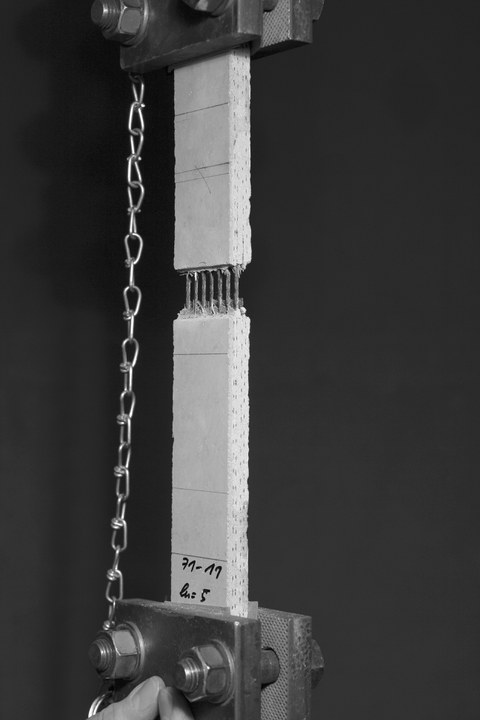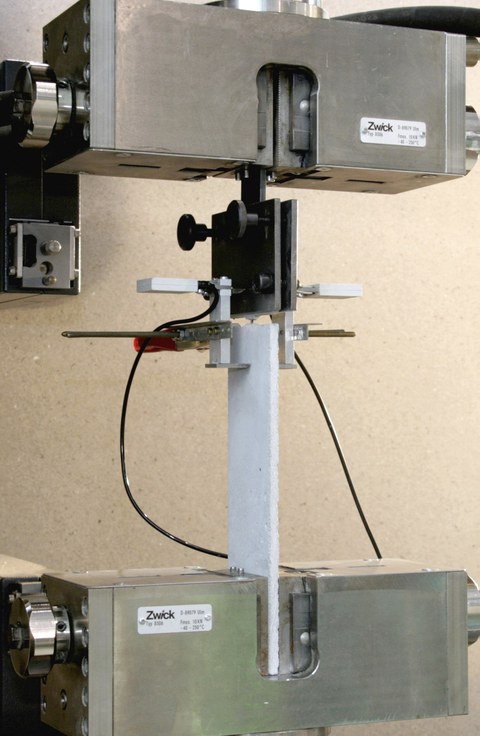CRC 528-B5: Fundamentals of structural reinforcement detailing of TRC
Table of contents
Project data
| Titel | Title SFB 528 B5: Grundlagen konstruktiver Bewehrungsdetails | CRC 528 B5: Fundamentals of structural reinforcement detailing of textile reinforced concrete Förderer | Funding Deutsche Forschungsgemeinschaft (DFG) / SFB 528 Zeitraum | Period 07/2009 – 06/2011 Leiterin | Project manager Dr.-Ing. Regine Ortlepp Bearbeiter | Contributor Dipl.-Ing. Enrico Lorenz M.Sc. |
See also here.
Report in the yearbook 2011
Lap Joints for Textile Fabrics

During 4-point bending test
With the aim of ensuring the transferability of the joints between textile reinforcements in strengthening layers made of textile reinforced concrete, which were constructed based on the results of uniaxial lap tests, bending tests were carried out on textile reinforced RC slabs with a lap joint positioned at the centre of the slab.
The examined RC slabs had a length of 2.7 m, a width of 60 cm and a thickness of 10 cm. In longitudinal direction, a steel reinforcement consisting of four pieces Ø = 8 mm was positioned at intervals of 15 cm. The textile reinforcement applied was made of practice oriented carbon textiles with textile cross sections of 169 mm²/m.
Before the RC slab was strengthened with textile reinforced concrete, it had been sandblasted to create a bonding joint which was sufficiently rough. After the RC slabs had been prewetted, the textile reinforced concrete was applied layer by layer. In the process a lap joint was created in the middle of the slab. The test regarding the load-bearing capacity of the slabs was carried out in 4-point bending tests with a span width of 2.50 m.
The tests confirmed that the ultimate tensile strength of the textile of 305 kN/m require lap lengths of 0.37 m in the textile reinforcement. Consequently, the rules and design specifications for the development and determination of lap lengths in strengthening layers made of textile reinforced concrete, which had already been deduced from uniaxial tension tests, could be verified. The tests showed also that the flexural strength of structural components reinforced by just one layer of textile reinforced concrete increased by approximately 150 % in comparison to unstrengthened RC slabs.
As a result, the experimental and analytical tests carried out in the framework of subproject B5 of the CRC 528 have contributed decisively to the arithmetic calculation and safe execution of textile reinforcement laps in strengthening layers made of textile reinforced concrete.
Report in the yearbook 2010
Overlap Joints in Strengthening Layers Made of TRC

Tension Test for determining the required overlap length
Usually, overlaps cannot be avoided when strengthening structures with textile reinforced concrete (TRC). Due to the two-dimensional structure of the textile fabrics as well as the composite being produced in layers, overlaps are normally implemented as two-ply joints
Overlap tests were carried out with one overlap at the centre of the sample to investigate the load-carrying behavior of such joints experimentally. The overlap tests followed the uniaxial tension tests (so-called strain specimen tests) which have already been well established.
Generally, a bond failure of textile reinforced concrete can occur in different ways. In connection with the overlaps, two failure mechanisms can be observed. On the one hand, failure can happen due to the threads being pulled from the fine grained concrete matrix. On the other hand, failure can also be caused by delamination/longitudinal matrix splitting within the overlap.
The overlap lengths are directly influenced by the extent of bond forces in the limit state of yarn pull-out. That means the required overlap length shortens when the transferable bond forces between yarn and matrix increase (e.g. by increasing the amount of coating to the textile rein-forcement).
The probability of bond failure by delamination is determined by those lateral tensile forces which result from load introduction and transmission within the overlap. Once the concrete’s tensile strength has been exceeded in the TRC layer, initially small longitudinal matrix splits develop at the beginning of the overlap. Under increased load these splits travel further into the overlap area and may, subsequently, lead to failure.
Based on the test results and the observed failure mechanisms a model was developed which can be used to accurately predict the required overlap lengths in the limit state of yarn pull-out. Furthermore, extensive analytic investigations were carried out to predict the probability of delamination failure. The obtained results yielded good correspondences with the values determined in the tests. Moreover, the tests and observations were used to define new requirements for the further development and optimization of the textile-matrix-system. These changes are currently applied with promising results.
Report in the yearbook 2009
Detailing of Reinforcement

Textile pull-out test
When existing concrete structures are strengthened with textile reinforced concrete (TRC) the method by which the TRC layer is anchored to the aged concrete is critical to the structure’s strengthening. Four different types of bond failure modes of these anchorage areas can occur. Three of these, which occur as a result of delamination; failure of the aged concrete; and destruction of the bond joint between the aged concrete and the new concrete, have previously been studied. Examination of the pullout of filament yarns from the fine-grained concrete matrix, especially in the case of textiles comprised of carbon fibres, showed that very high tensile strength largely serve as the determining factor of required development lengths. This finding, therefore, prompted further study of the failure criteria of yarn pullout.
Initially, the bond behaviour between yarn surface and the fine-grained concrete matrix was experimentally analyzed by using pull-out tests. The bond problem is shown analytically based on multi-linear solutions of the bond differential equation using the experimentally determined force-crack-opening-relationship. The required anchorage length for a corresponding force, F, could be calculated in the third step of the process by applying a separate model in which the yarn-specific bond-slip-relationship determined in the second step was the basis.
The values obtained from independent experimental tests of the determination of the anchoring length were conducted to verify the validity of the relationship determined. The correspondence between the calculated anchoring lengths and the experimentally determined lengths is good.
The enhanced knowledge of the laminar failure modes of these connections provides for a comprehensive analytical determination of the development lengths of TRC layers. In addition to the prediction of the required anchorage lengths, the specific parameters of the textile-concrete bond interface can be used to calculate overlapping lengths as well as to predict crack spacing and related crack widths of an overall crack pattern.
